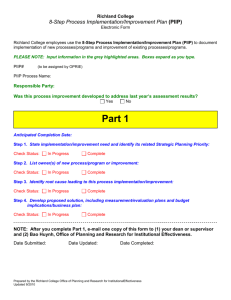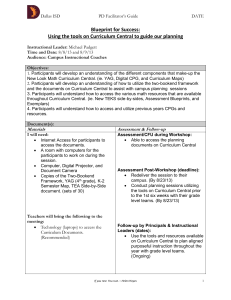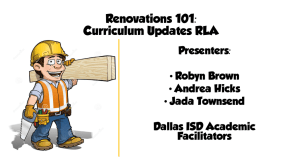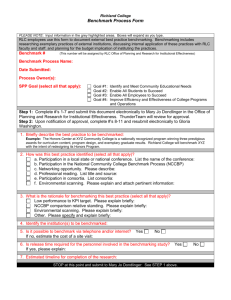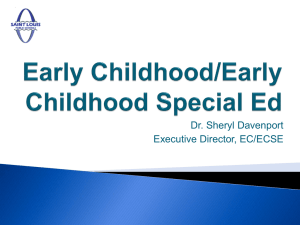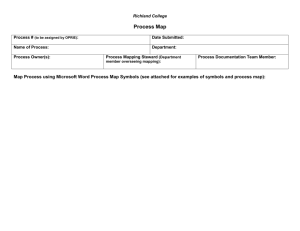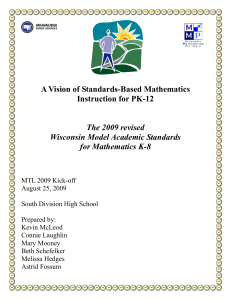MICHIGAN EDUCATION TECHNOLOGY STANDARDS
advertisement
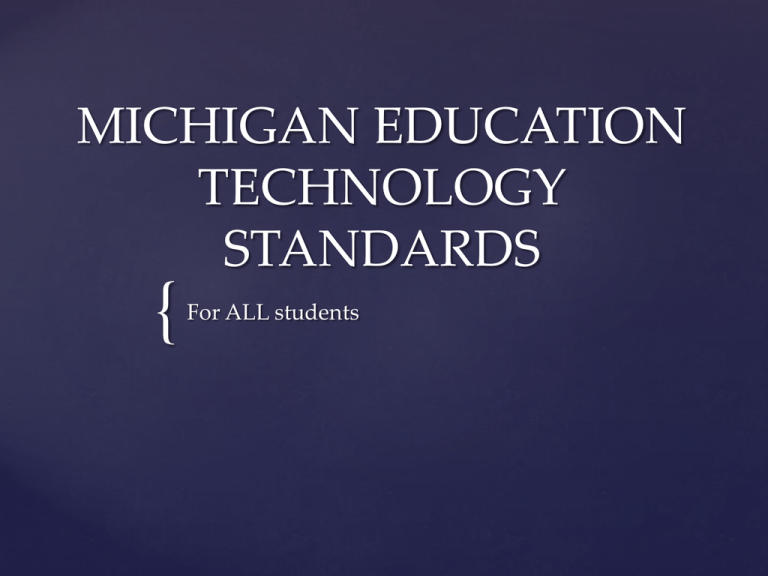
MICHIGAN EDUCATION
TECHNOLOGY
STANDARDS
{
For ALL students
Creativity and Innovation
K-2.CI.1. use a variety of digital tools (e.g., word
processors, drawing tools, simulations,
presentation software, graphical organizers) to
learn, create, and convey original ideas or
illustrate concepts
Creativity and Innovation
3-5.CI.1. produce a media-rich digital project aligned to state
curriculum standards (e.g., fable, folk tale, mystery, tall tale,
historical fiction)
3-5.CI.2. use a variety of technology tools and applications to
demonstrate his/her creativity by creating or modifying works of
art, music, movies, or presentations
3-5.CI.3. participate in discussions about technologies (past,
present, and future) to understand these technologies are the
result of human creativity
Communication and
Collaboration
PK-2.CC.1. work together when using digital tools (e.g., word
processor, drawing, presentation software) to convey ideas or
illustrate simple concepts relating to a specified project
PK-2.CC.2. use a variety of developmentally appropriate digital
tools (e.g., word processors, paint programs) to communicate
ideas to classmates, families, and others
Communication and
Collaboration
3-5.CC.1. use digital communication tools (e.g., e-mail, wikis,
blogs, IM, chat rooms, videoconferencing, Moodle,Blackboard)
and online resources for group learning projects
3-5-2.CC.2. identify how different software applications may be
used to share similar information, based on the intended
audience (e.g., presentations for classmates, newsletters for
parents)
3-5-2.CC.3. use a variety of media and formats to create and edit
products (e.g., presentations, newsletters, brochures, web pages)
to communicate information and ideas to various audiences
Research and Information
PK-2.RI.1. interact with Internet based
resources
PK-2.RI.2. use digital resources (e.g.,
dictionaries, encyclopedias, graphs, graphical
organizers) to locate and interpret information
relating to a specific curricular topic, with
assistance from teachers, school library media
specialists, parents, or student partners
Research and Information Literacy
3-5.RI.1. identify search strategies for locating information
with support from teachers or library media specialists
3-5.RI.2. use digital tools to find, organize, analyze,
synthesize, and evaluate information
3-5.RI.3. understand and discuss that web sites and digital
resources may contain inaccurate or biased information
3-5.RI.4. understand that using information from a single
Internet source might result in the reporting of erroneous
facts and that multiple sources should always be researched
Critical Thinking, Problem Solving,
and Decision Making
PK-2.CT.1. explain ways that technology can be used to
solve problems (e.g., cell phones, traffic lights, GPS units)
PK-2.CT.2. use digital resources (e.g., dictionaries,
encyclopedias, search engines, web sites) to solve
developmentally appropriate problems, with assistance
from teachers, parents, school media specialists, or student
partners
Critical Thinking and Problem Solving
3-5.CT.1. use digital resources to access information that can
assist in making informed decisions about everyday matters (e.g.,
which movie to see, which product to purchase)
3-5.CT.2. use information and communication technology tools
(e.g., calculators, probes, videos, DVDs, educational software) to
collect, organize, and evaluate information to assist with solving
problems
3-5.CT.3. use digital resources to identify and investigate a state,
national, or global issue (e.g., global warming, economy,
environment)
Digital Citizenship—
PK-2.DC.1. describe appropriate and inappropriate uses of
technology (e.g., computers, Internet, e-mail, cell phones) and
describe consequences of inappropriate uses
PK-2.DC.2. know the Michigan Cyber Safety Initiative’s three rules
(Keep Safe, Keep Away, Keep Telling)
PK-2.DC.3. identify personal information that should not be shared
on the Internet (e.g. name, address, phone)
PK-2.DC.4. know to inform a trusted adult if he/she receives or
views an online communication which makes him/her feel
uncomfortable, or if someone whom he/she doesn’t know is trying to
communicate with him/her or asking for personal information
Digital Citizenship
3-5.DC.1. discuss scenarios involving acceptable and
unacceptable uses of technology (e.g., file-sharing, social
networking, text messaging, cyber bullying, plagiarism)
3-5.DC.2. recognize issues involving ethical use of information
(e.g., copyright adherence, source citation)
3-5.DC.3. describe precautions surrounding personal safety that
should be taken when online
3-5.DC.4. identify the types of personal information that should
not be given out on the Internet (name, address, phone number,
picture, school name)
Technology Operations and Concepts
PK-2.TC.1. discuss advantages and disadvantages of using technology
PK-2.TC.2. be able to use basic menu commands to perform common
operations (e.g., open, close, save, print)
PK-2.TC.3. recognize and name the major hardware components in a
computer system (e.g., computer, monitor, keyboard,
mouse, printer)
PK-2.TC.4. discuss the basic care for computer hardware and various media
types (e.g., CDs, DVDs)
PK-2.TC.5. use developmentally appropriate and accurate terminology when
talking about technology
PK-2.TC.6. understand that technology is a tool to help him/her complete a
task, and is a source of information, learning, and entertainment
PK-2.TC.7. demonstrate the ability to navigate in virtual environments (e.g.,
electronic books, games, simulation software,web sites)
Technology Operations
3-5.TC.1. use basic input and output devices (e.g., printers, scanners,
digital cameras, video recorders, projectors)
3-5.TC.2. describe ways technology has changed life at school and at home
3-5.TC.3. understand and discuss how assistive technologies can benefit all
individuals
3-5.TC.4. demonstrate proper care in the use of computer hardware,
software, peripherals, and storage media
3-5.TC.5. know how to exchange files with other students using
technology (e.g., network file sharing, flash drives)
ARE YOU EMBEDDING?
Skyping authors or other classrooms
Online field trips like STARWALK or Visit the Catacombs
Online simulation of animal dissections, or simple machines
Solving real world solutions with spreadsheets
Using mobile technologies to read aloud a story
Mobile devices to record a student reading outloud
